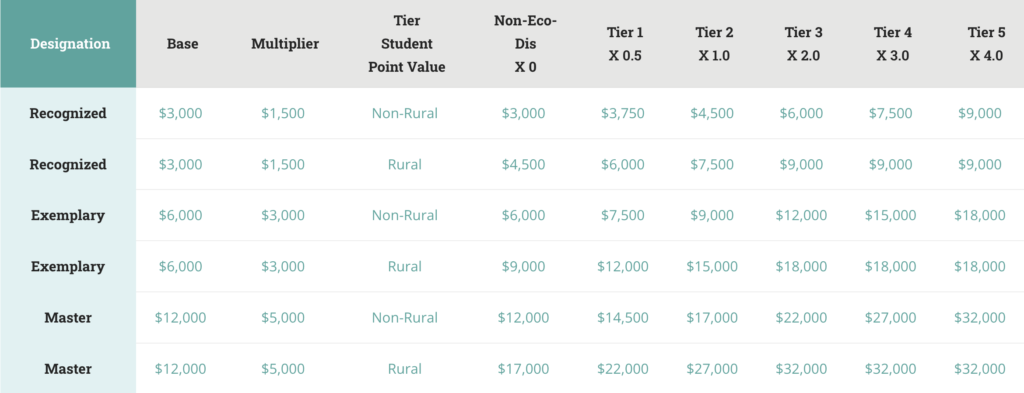The public education system in Texas plays a critical role in shaping our children’s future. Dedicated, hardworking teachers are the backbone of this system. Because of this, Texas introduced the Teacher Incentive Allotment (TIA) program to attract, recognize, reward, and keep exceptional teachers.
A vital component of this initiative is the teacher designation levels. They aim to incentivize teachers to excel in their profession while elevating the overall quality of education in the state. This blog post will explore the significance of teacher designation levels for the Teacher Incentive Allotment.
What are Teacher Designation Levels?
At the heart of the TIA are the teacher designation levels. These designations are good for five years. They also classify educators based on their demonstrated effectiveness in the classroom and the academic growth of their students. The TIA recognizes three teacher designation levels, each with its own criteria and corresponding incentives. Let’s explore each group.

1. Master Teacher
This is the highest designation level. A Master teacher designation is awarded to educators who exhibit exceptional teaching skills and consistently achieve outstanding results with their students. These educators also excel in their subject matter and foster a positive learning environment promoting student engagement and academic growth.
Teachers designated as Master receive a significant monetary reward of $12,000- $32,000 and professional recognition for their outstanding educational contributions. Master teachers represent approximately 5% of educators in the state of Texas.
2. Exemplary Teacher
Teachers who consistently demonstrate excellent teaching effectiveness and substantial student academic progress are given an Exemplary designation. These outstanding educators excel in the classroom, and their students also show commendable academic growth.
Exemplary teachers receive a significant financial incentive between $6,000- $18,000 and are celebrated for their contributions to student achievement. In addition, teachers who have earned an Exemplary designation rank in Texas’s top 20% of educators.
3. Recognized Teacher
Teachers who achieve the designation level of Recognized exhibit above-average teaching practices and positively impact their students’ academic growth. These educators are also skilled in delivering curriculum content, managing classrooms, and fostering a supportive learning environment that promotes academic growth.
The Recognized designation also comes with monetary incentives of $3,000- $9,000, acknowledging the teacher’s dedication to their profession and student success. Recognized teachers represent approximately one-third of educators in the state of Texas.
How is Funding Determined with Teacher Designation Levels?
The funding available from TIA varies by the designation of the teacher and the campus where the designated teacher works. Furthermore, the exact amount of allotment funding per teacher is determined by a formula that considers the level of socioeconomic need at a campus and whether the campus is rural. Teacher designations have a base allotment amount and a multiplier rate based on each specific designation level: Recognized, Exemplary, or Master.
Each student at the designated teacher’s campus is assigned a tier determined by the census block of the student’s home address. Each tier also carries a point value: 0, 0.5, 1.0, 2.0, 3.0, and 4.0 (from least to most severe economic disadvantage). These tiers are the same tiers used for Compensatory Education. As the tier designation increases, so does the need.
Students at rural schools are assigned two tiers higher than their given Compensatory Education tier. This increases the point value accordingly. For example, rather than a point value of 1.0, a teacher at a rural campus will be assigned a point value of 3.0. Note the highest tier possible is tier 5.
The campus is assigned an average student point value based on the tier levels and corresponding point values for each student. This value is used in the allotment formula calculation. The average point value is then multiplied by the designation’s multiplier rate. That value is added to the designation’s base allotment, giving the total incentive allotment. Essentially, the Allotment = Base + (Multiplier x Average Student Point Value).

Why Participate in the Teacher Incentive Allotment?
Finally, the Texas Teacher Incentive Allotment program aims to recognize and reward exceptional teachers. Teacher designation levels form the foundation of this initiative. Educators are categorized based on their effectiveness in the classroom and their impact on student growth. By providing meaningful incentives and professional recognition, the TIA motivates teachers to strive for excellence and also invest in their continuous professional development.
The TIA has not only elevated the teaching profession but also contributed to improved student outcomes. Texas has taken a significant step toward ensuring a bright future for its students and the education system by acknowledging and supporting exemplary educators. As the program continues to evolve, it is expected to inspire teachers to reach new heights of excellence while fostering a culture of continuous improvement in education throughout the state.
John is an Administrative Specialist for Educator Evaluation and Leadership at ESC Region 13.






I met the requirements for the TIA allotment at Master level last year. My school district is rural and the majority of our families are socioeconomically disadvantaged. I noticed according to the scale posted on ,”Understanding the Teacher Incentive Allotment: Teacher Designation Levels”, that my allotment isn’t matching up. It is coming in considerably less and this second year receiving it, the allotment amount decreased. Please guide me regarding how this can happen.
Hi Edith. Allotment amounts for TIA are dependent on several factors and often do change from year to year. You already mentioned two important factors: 1. The rural status of the campus; and 2. The socioeconomic status of the student population. If allotment amounts have changed, it is a possibility that the rural status of the campus changed, but more likely it is because the number of students on the campus with a low socioeconomic status that has decreased. A change in either of those factors would result in varying allotment amounts for the designated teachers on a given campus. The third factor to consider is what is outlined in the district’s approved TIA spending plan about the percentage of an allotment that is awarded directly to the designated teacher. That is a local decision and can vary from district to district.The rule about awarding allotment amounts is that at least 90% of the allotment must be spent on teacher compensation on the campus where the designated teacher worked. How that 90%+ is distributed will be in the district’s approved Local Designation System.
What can you do? First, take a look at the funding map found at https://tiatexas.org/funding-map/. Type in your campus name, and if needed, your district name, and ESC Region to bring up the allotment amounts for your specific campus. Once you have that information, you’ll need to see how those allotments are distributed according to the district’s approved TIA plan. Once you know what your allotment amount is and how the district agreed to distribute the funds, you should be able to get a pretty good idea of what you should receive as a designated teacher before deductions for taxes, TRS, etc. If you still have questions, it is advisable to contact your district’s local TIA Lead. They should be able to answer any questions about how allotment funds are distributed according to the district’s approved TIA plan.